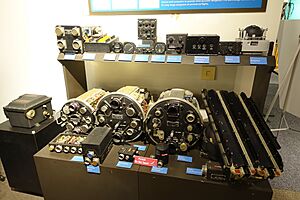Doppler radar facts for kids
A Doppler radar is a special type of radar that uses something called the Doppler effect to figure out how fast objects are moving and in what direction. It works by sending out a microwave signal. When this signal hits an object, it bounces back to the radar. The radar then checks how the object's movement changed the signal's frequency. This change in frequency tells the radar about the object's velocity (speed and direction).
Contents
How Doppler Radar Was Developed
Doppler radar systems are often lighter than other radar types. This is because they don't need some of the heavy parts that older radars used. This lighter design helps them work better over longer distances and use less power. The military started using these advantages in the 1940s.
During World War II, a type of Doppler radar called continuous-broadcast (or FM) radar was made for United States Navy aircraft. This helped bombers fly at the best speed when attacking ships at night. It also helped fighter planes aim their guns at enemy aircraft in the dark.
In the 1970s, new computer technology made it possible to use digital filters in Doppler radar. This was a big step forward! It helped extract speed information from radar signals, which was very useful for both weather and air traffic control radars. This new information helped computers track objects better.
As digital technology became smaller and cheaper, special Doppler radars were developed. Pulse-Doppler radars, for example, can detect both fast-moving targets and measure their speed very accurately. Weather radars are good at measuring speed with high detail, while radars used for air defense can detect a wide range of speeds, even if the exact speed isn't super precise.
Modern Doppler systems are now light enough to be used on the ground by soldiers or on ships. They can detect movement from vehicles and people, which is helpful for fighting at night or in bad weather. The radar guns that police use to check car speeds are smaller, portable versions of these systems.
Understanding the Doppler Effect
What is the Doppler Effect?
The Doppler effect is named after Christian Doppler, an Austrian physicist. It's the change in the sound or light frequency you hear or see when the source of the waves (like a siren) is moving relative to you.
You've probably heard the Doppler effect! Think about an ambulance siren. When it's coming towards you, the sound seems higher pitched. As it passes you, the pitch drops. And when it moves away, the sound seems lower pitched. This happens because the sound waves get squished together as the ambulance comes closer (higher frequency) and stretched out as it moves away (lower frequency).
Imagine a baseball pitcher throwing one ball every second. If the pitcher stands still, the catcher catches one ball every second. But if the pitcher jogs towards the catcher, the catcher will catch balls more often because the balls are closer together. If the pitcher jogs away, the catcher will catch balls less often because the balls are more spread out. This change in how often the catcher gets balls is like the Doppler effect.
For radar, instead of sound waves or baseballs, we're talking about microwave signals. The radar sends out microwaves, and when they hit a moving object, the frequency of the reflected microwaves changes. This change tells the radar how fast the object is moving towards or away from it.
How Doppler Technology Works
Doppler radar uses this effect to filter out unwanted signals. For example, it can ignore signals from slow-moving or still objects like trees, clouds, insects, or even wind. This helps the radar focus only on the moving targets it's interested in.
There are different ways Doppler radar can work:
- Continuous Wave (CW) Doppler radar: This type only tells you the speed of an object. It compares the frequency of the signal it receives from the target with the original signal it sent out.
- Frequency Modulated Continuous Wave (FMCW) radar: This is an improved version of CW radar. It changes the frequency of the signal it sends out, which allows it to figure out both the speed and the distance of an object.
- Pulse-Doppler radar: These radars send out short pulses of microwaves. By combining Doppler processing with these pulses, they can get very accurate speed information, especially for fast-moving objects.
In military airplanes, the Doppler effect is very useful. It helps the radar ignore signals from weather, the ground, or enemy countermeasures like chaff. This makes it easier for pilots and computers to find and track enemy targets, especially those flying low to the ground.
What Doppler Radar Is Used For
Doppler radars are used in many different areas:
- Aviation: Helping planes navigate and avoid collisions.
- Weather forecasting: Doppler weather radar helps meteorologists see storms, measure wind speeds, and predict severe weather like tornadoes.
- Sports: Systems like Major League Baseball's StatCast use Doppler radar to track baseballs and players.
- Police: Radar guns use Doppler radar to measure the speed of cars.
- Healthcare: Used in radiology and for things like detecting falls or monitoring patients.
- Missile systems: In bistatic radar systems, like those used for surface-to-air missiles.
Images for kids
-
The first experimental Doppler weather radar unit used by the US Weather Bureau in the 1950s.
-
A Doppler navigation system on display at the National Electronics Museum.
See also
 In Spanish: Radar Doppler para niños
In Spanish: Radar Doppler para niños







